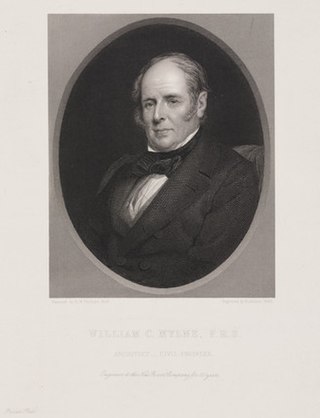
George Bannatyne (1545–1608), a native of Angus, Scotland, was an Edinburgh merchant and burgess. He was the seventh of twenty-three children, including Catherine Bannatyne, born of James Bannatyne of Kirktown of Newtyle in Forfarshire and Katherine Tailefer. He is most famous as a collector of Scottish poems. He compiled an anthology of Scots poetry while in isolation during a plague in 1568. His work extended to eight hundred folio pages, divided into five parts. The anthology includes works from Scottish Chaucerians as well as many anonymous writers.

William Burn was a Scottish architect. He received major commissions from the age of 20 until his death at 81. He built in many styles and was a pioneer of the Scottish Baronial Revival, often referred to as the golden age of Scottish architecture.

Liff is a village in Angus, Scotland, situated 4+1⁄2 miles west-northwest of Dundee on a south-facing slope two miles north of the River Tay. It had a population of 568 in 2011.

William Chadwell Mylne, FRS was an English civil engineer and architect. He was descended from a Scottish family of masons and architects, and was the second son of Robert Mylne (1733–1811), surveyor to the New River Company, and builder of the first Blackfriars Bridge in London.
Mylne is a surname. Notable people with the surname include:

Sir William Bruce of Kinross, 1st Baronet, was a Scottish gentleman-architect, "the effective founder of classical architecture in Scotland," as Howard Colvin observes. As a key figure in introducing the Palladian style into Scotland, he has been compared to the pioneering English architects Inigo Jones and Christopher Wren, and to the contemporaneous introducers of French style in English domestic architecture, Hugh May and Sir Roger Pratt.

James Smith was a Scottish architect, who pioneered the Palladian style in Scotland. He was described by Colen Campbell, in his Vitruvius Britannicus (1715–1725), as "the most experienced architect of that kingdom".

John Mylne of Perth was a Scottish master mason who served as Master Mason to the Crown of Scotland. He was born in Perth, the son of John Mylne, also a master mason, and Helen Kenneries.

William Wallace was a Scottish master mason and architect. He served as King's Master Mason under James VI.

John Mylne, sometimes known as "John Mylne junior", or "the Younger", was a Scottish master mason and architect who served as Master Mason to the Crown of Scotland. Born in Perth, he was the son of John Mylne, also a master mason, and Isobel Wilson.
Alexander McGill was a Scottish mason and architect, who worked in partnership with fellow architect James Smith. His work was influenced by that of Sir William Bruce, and some of his designs later appeared in William Adam's Vitruvius Scoticus.
The Scottish Midland Junction Railway was authorised in 1845 to build a line from Perth to Forfar. Other companies obtained authorisation in the same year, and together they formed a route from central Scotland to Aberdeen. The SMJR opened its main line on 4 August 1848. Proposals to merge with other railways were rejected by Parliament at first, but in 1856 the SMJR merged with the Aberdeen Railway to form the Scottish North Eastern Railway. The SNER was itself absorbed into the larger Caledonian Railway in 1866. The original SMJR main line was now a small section of a main line from Carlisle and central Scotland to Aberdeen.

Newtyle is a village in the west of Angus, Scotland. It lies eleven miles north of Dundee in the southwest of Strathmore, between Hatton Hill and Newtyle in the Sidlaws. The village sits on gently sloping ground with a northwest aspect. The main communication link is the B954 road. The population was about 800 as of 2004.

Robert Mylne was a Scottish stonemason and architect. A descendant of the Mylne family of masons and builders, Robert was the last Master Mason to the Crown of Scotland, a post he held from 1668 until his death.
William Mylne (1734–1790) was a Scottish architect and engineer. He is best known as the builder of the North Bridge, which links the Old and New Towns of Edinburgh, Scotland. He was the younger brother of Robert Mylne, architect and designer of Blackfriars Bridge in London.
Patrick Galloway was a Scottish minister, a Moderator of the General Assembly of the Church of Scotland. He was Moderator of the General Assembly in 1590, and again in 1602. Having been completely gained over by the Court party he used all his influence in forwarding the views of the King for the introduction of Episcopacy.
Patrick Gray, 4th Lord Gray was a Scottish landowner and Sheriff of Angus, active during the war of the Rough Wooing as a supporter of the Scottish Reformation.

Architecture in early modern Scotland encompasses all building within the borders of the kingdom of Scotland, from the early sixteenth century to the mid-eighteenth century. The time period roughly corresponds to the early modern era in Europe, beginning with the Renaissance and Reformation and ending with the start of the Enlightenment and Industrialisation.

Greyfriars Burial Ground is an historic cemetery in Perth, Scotland, dating to 1580. It is now Category A listed, with its collection of gravestones considered one of the best in Scotland. The cemetery closed to burials in 1978.

The House of Falkland, in Falkland, Fife, Scotland, is a 19th-century country house and has been one of the homes of John Crichton-Stuart, 3rd Marquess of Bute and the Crichton-Stuart family. The house has been designed in the 19th-century revival of late 16th and early 17th-century Elizabethan and Jacobean styles called Jacobethan.














